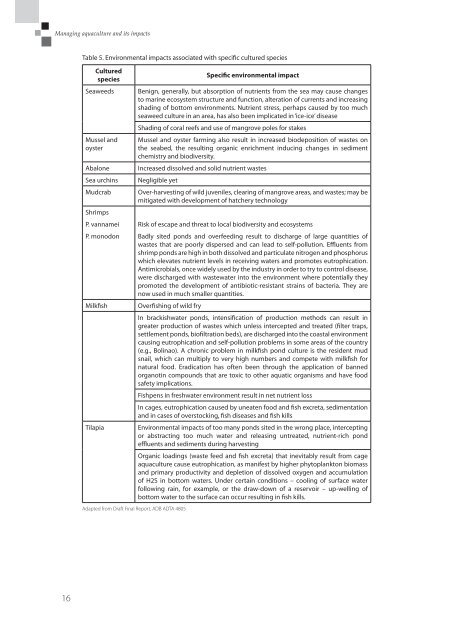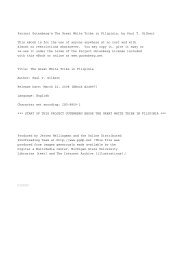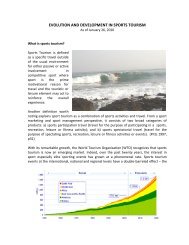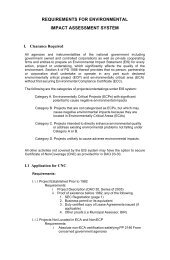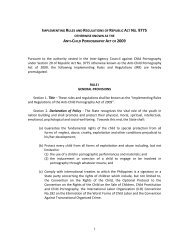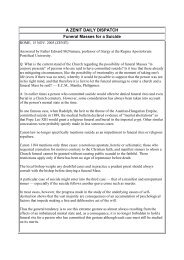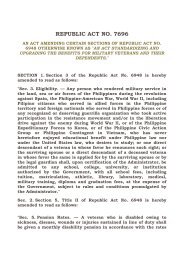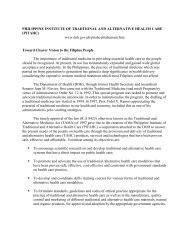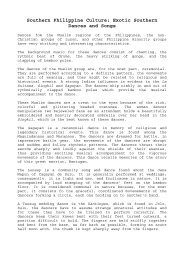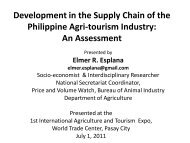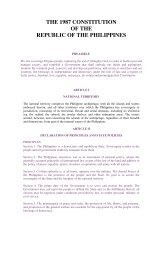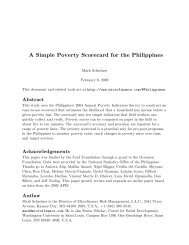Untitled - About the Philippines
Untitled - About the Philippines
Untitled - About the Philippines
Create successful ePaper yourself
Turn your PDF publications into a flip-book with our unique Google optimized e-Paper software.
Managing aquaculture and its impacts: a guidebook for local governments<br />
Table 5. Environmental impacts associated with specific cultured species<br />
Cultured<br />
species<br />
Seaweeds<br />
Mussel and<br />
oyster<br />
Abalone<br />
Sea urchins<br />
Mudcrab<br />
Shrimps<br />
Specific environmental impact<br />
Benign, generally, but absorption of nutrients from <strong>the</strong> sea may cause changes<br />
to marine ecosystem structure and function, alteration of currents and increasing<br />
shading of bottom environments. Nutrient stress, perhaps caused by too much<br />
seaweed culture in an area, has also been implicated in ‘ice-ice’ disease<br />
Shading of coral reefs and use of mangrove poles for stakes<br />
Mussel and oyster farming also result in increased biodeposition of wastes on<br />
<strong>the</strong> seabed, <strong>the</strong> resulting organic enrichment inducing changes in sediment<br />
chemistry and biodiversity.<br />
Increased dissolved and solid nutrient wastes<br />
Negligible yet<br />
Over-harvesting of wild juveniles, clearing of mangrove areas, and wastes; may be<br />
mitigated with development of hatchery technology<br />
P. vannamei Risk of escape and threat to local biodiversity and ecosystems<br />
P. monodon Badly sited ponds and overfeeding result to discharge of large quantities of<br />
wastes that are poorly dispersed and can lead to self-pollution. Effluents from<br />
shrimp ponds are high in both dissolved and particulate nitrogen and phosphorus<br />
which elevates nutrient levels in receiving waters and promotes eutrophication.<br />
Antimicrobials, once widely used by <strong>the</strong> industry in order to try to control disease,<br />
were discharged with wastewater into <strong>the</strong> environment where potentially <strong>the</strong>y<br />
promoted <strong>the</strong> development of antibiotic-resistant strains of bacteria. They are<br />
now used in much smaller quantities.<br />
Milkfish<br />
Tilapia<br />
Overfishing of wild fry<br />
Adapted from Draft Final Report, ADB ADTA 4805<br />
In brackishwater ponds, intensification of production methods can result in<br />
greater production of wastes which unless intercepted and treated (filter traps,<br />
settlement ponds, biofiltration beds), are discharged into <strong>the</strong> coastal environment<br />
causing eutrophication and self-pollution problems in some areas of <strong>the</strong> country<br />
(e.g., Bolinao). A chronic problem in milkfish pond culture is <strong>the</strong> resident mud<br />
snail, which can multiply to very high numbers and compete with milkfish for<br />
natural food. Eradication has often been through <strong>the</strong> application of banned<br />
organotin compounds that are toxic to o<strong>the</strong>r aquatic organisms and have food<br />
safety implications.<br />
Fishpens in freshwater environment result in net nutrient loss<br />
In cages, eutrophication caused by uneaten food and fish excreta, sedimentation<br />
and in cases of overstocking, fish diseases and fish kills<br />
Environmental impacts of too many ponds sited in <strong>the</strong> wrong place, intercepting<br />
or abstracting too much water and releasing untreated, nutrient-rich pond<br />
effluents and sediments during harvesting<br />
Organic loadings (waste feed and fish excreta) that inevitably result from cage<br />
aquaculture cause eutrophication, as manifest by higher phytoplankton biomass<br />
and primary productivity and depletion of dissolved oxygen and accumulation<br />
of H2S in bottom waters. Under certain conditions – cooling of surface water<br />
following rain, for example, or <strong>the</strong> draw-down of a reservoir – up-welling of<br />
bottom water to <strong>the</strong> surface can occur resulting in fish kills.<br />
16


